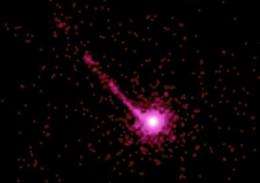February 25, 2015 weblog
Distant quasar spectrum reveals no sign of changes in mass ratio of proton and electron over 12 billion years

A team of space researchers working with data from the VLT in Chile has found via measuring the spectrum of a distant quasar by analyzing absorption lines in a galaxy in front of it, that there was no measurable change in the mass ratio of protons and electrons over a span of 12 billion years. In their paper published in the journal Physical Review Letters, the team, made up of two members from VU University in the Netherlands, and two members from Swinburne University of Technology in Australia, describe their findings and what it might mean for helping to explain dark energy.
Some theories suggest that dark energy, the mysterious force that has the universe continuing to expand, might be a field that evolves over time—if so, that might mean that some of the constants we take for granted, such as gravity, the speed of light, etc., might actually evolve as well. In this new effort, the researchers sought to test that idea by looking to see if the mass of protons or electrons (both of which are considered to be fundamental constants) and the ratio that describes their mass difference, changed over the course of billions of years.
To find out if that might be the case, the researchers looked to a distant quasar, one positioned behind a galaxy, relative to us. Quasars are still somewhat mysterious, described as celestial objects that emit a huge amount of energy and light—they look like stars, but some believe they actually hold black holes.
The researchers found that molecular hydrogen in the galaxy absorbed some of the light from the quasar allowing them to measure the energy transitions that occurred and thus the mass ratio of protons and electrons. Since the galaxy had been previously dated to 12.4 billion years ago, the light reaching it from the quasar must be even older. Their measurements showed no deviation (with a precision of 10–6) from the current constant, suggesting that the ratio has remained constant for at least 12 billon years. And this, the researchers claim, suggests that if dark energy is evolving, it has not done so over that time span.
via physicsworld.com
More information: Phys. Rev. Lett. 114, 071301 (2015) DOI: 10.1103/PhysRevLett.114.071301
Journal information: Physical Review Letters
© 2015 Phys.org



















